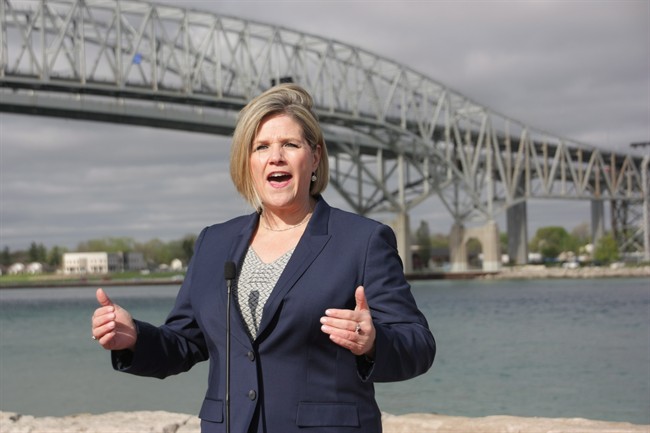Cut the waste. Respect for tax dollars. Government that makes sense.

These are the buzzwords of Ontario’s New Democrats. And if they sound more like Rob Ford than Tommy Douglas (or Jack Layton), that’s not by accident. Leader Andrea Horwath is doubling down on the populist platform she ran on in 2011, eschewing the party’s traditional progressive principles in the process.
It’s a gamble intended to capitalize on election and byelection gains the NDP made in blue-collar ridings such as Windsor-Tecumseh, leveraging Horwath’s likeability to appeal to voters as the average guy’s party.
If it works, it could open up strategic blocs of support in regions such as southwestern Ontario, as well as rural or suburban ridings that aren’t traditional NDP territory.
Star candidate Jagmeet Singh, for example, nabbed the provincial NDP’s first Peel Region seat when he won Bramalea-Gore-Malton in 2011, thanks both to his own community connections and the party’s focus on auto insurance rates – a huge issue in the area.
READ MORE: Full interview with Andrea Horwath
But if this strategy backfires, it could cost the NDP long-held lefty seats as voters who normally bleed orange are turned off by the nouveau populism – enough to vote Liberal, Green or stay home altogether.
But the way Horwath tells it, she’s just reflecting the priorities of ordinary Ontarians.
“I don’t think people see things in those terms” of progressive versus populist, she said in an interview. “I think what people want is a government that makes sense and that can actually deliver on its promises. And I think the Liberals have shown that they can’t. …
“I think the most important thing that any political party should do is listen to the people they purport to represent and then try to solve the problems they identify. And that’s why we’re focused on jobs, we’re focused on affordability, we’re focused on respecting the tax dollar.”
WATCH: The NDP’s populist ‘common sense’ revolution
In many ways, Horwath’s signature policies have been identical to the ones she ran on in 2011: Cuts to the HST, lower car insurance rates, tax credits for businesses investing in jobs or infrastructure. The platform document on the party’s website refers to an Oct. 6 election date (that would be Oct. 6, 2011). But more ideas are coming, she says.
“We want to make sure we are taking the time to bring our ideas forward in a way that people can grasp them and can take the time to look at them thoughtfully. So we’re not going to lay them on the table all at once because that way everything gets lost in the shuffle,” she said.
WATCH: Is the NDP running on its 2011 platform?
In the meantime, Horwath’s populist policies and Hudak’s promise of public-sector pink slips have spooked one of the NDP’s traditional allies when it comes to mobilizing votes: organized labour – the same movement that gave Horwath, poring over her dad’s union literature, her first taste of politics.
“It’s a populist agenda moving away from our social democratic roots. And it’s causing a problem for the grassroots,” says Ontario Federation of Labour President Sid Ryan.
“You need to mobilize your base, you need to get your people energized to go out, knock on doors. And that kind of a populist agenda doesn’t really energize the NDP base. No one’s very much excited about $100 rebates and reductions in auto insurance.”
In the meantime, union rank and file are operating under what Ryan calls a “smart voting” strategy: Voting for the NDP in ridings where it looks like the party will win, and Liberal everywhere else.
- ‘Pretty scary’: Ill Ontario man stranded in Costa Rica finally recovering in Canada
- S&P/TSX composite down, U.S. markets mixed ahead of tech earnings and economic data
- 1 deal falls through but Toronto FC completes another in Derrick Etienne Jr. trade
- Big warm-up to follow blast of cold air in southern Ontario
Western University politics professor Cristine de Clercy isn’t sure it’s so clear-cut.
But left-wing firebrand (and lifelong NDPer) Judy Rebick is not impressed.
“I know a lot of people who have ripped up their cards, decided not to donate and are really considering not voting,” she said. “I’ve voted NDP my whole life but … I just don’t know what they stand for any more.”
With files from Sean Mallen in Toronto




Comments